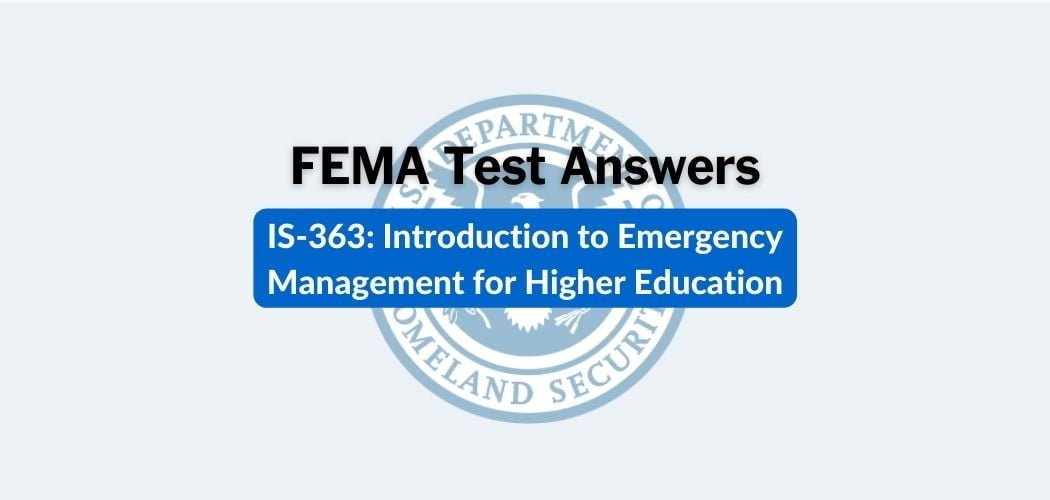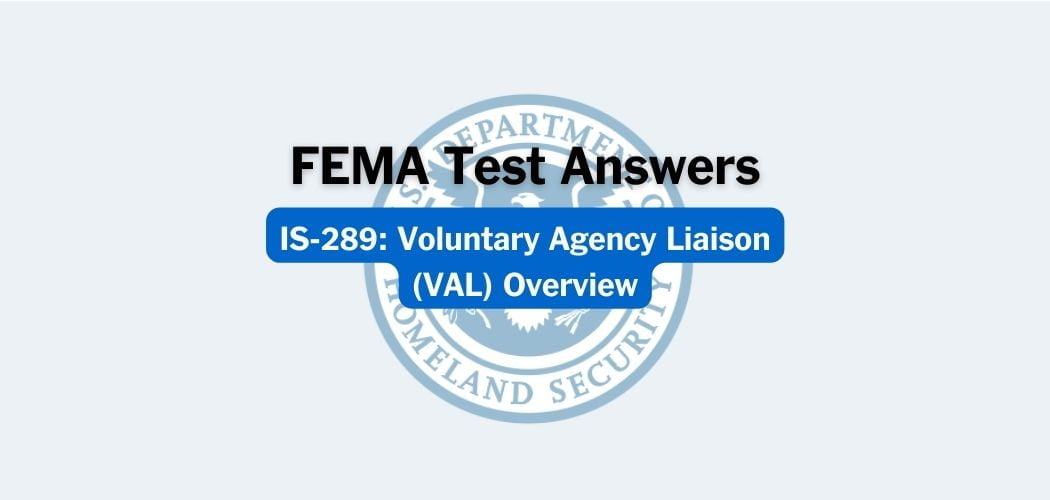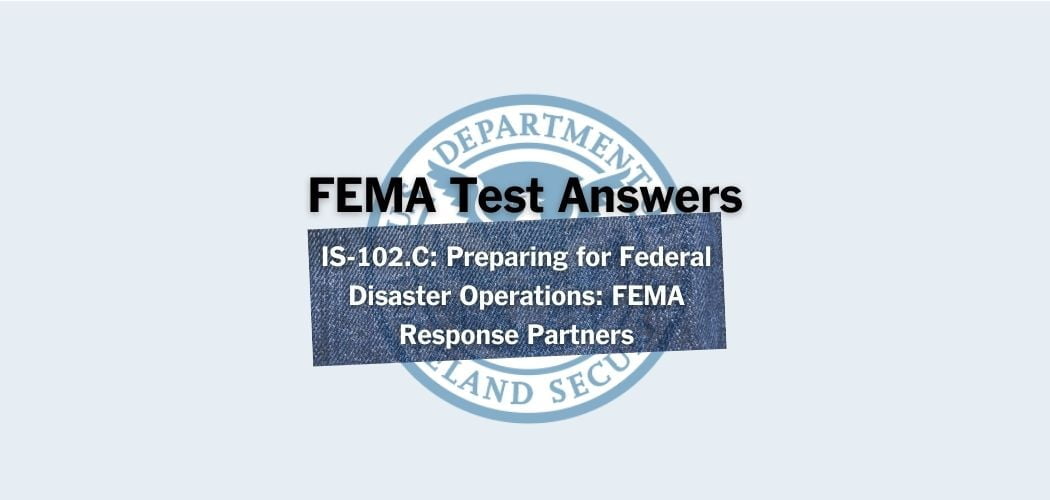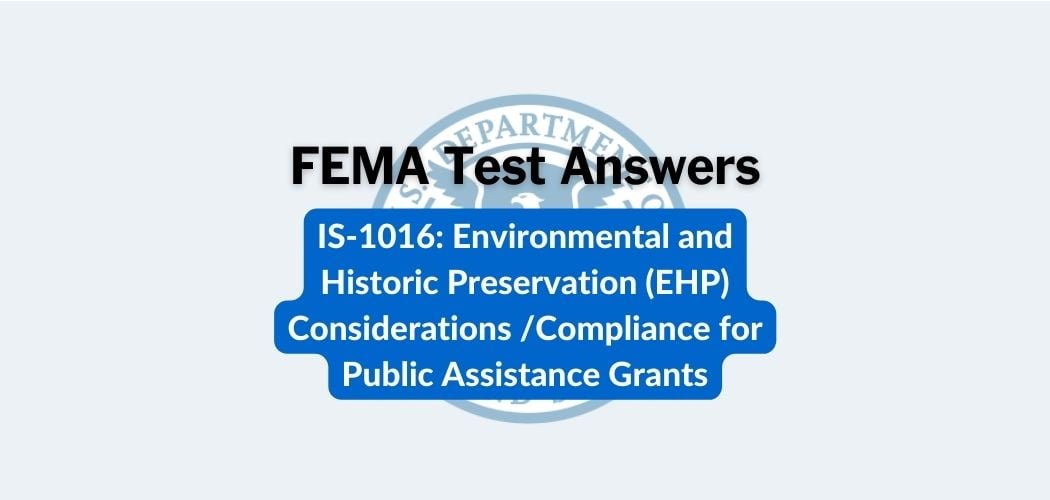Overview: The FEMA IS-800.D course was published on 5/6/2020 to provide guidance for the whole community about the purpose, scope, organization, and underlying doctrine of the National Response Framework. It also describes the roles and responsibilities of response partners.
Primary audience: FEMA IS-800.D course is intended to provide guidance for the whole community. Within this broad audience, the National Response Framework focuses especially on those who are involved in delivering and applying the response core capabilities.
FEMA IS-800.D test answers
Each time this test is loaded, you will receive a unique set of questions and answers. The test questions are scrambled to protect the integrity of the exam.
Question 1. Which of the following is a mission area?
A. Recovery✅
B. Reaction
C. Operational Coordination
D. Planning
Question 2. The Unified Coordination Group:
A. Is a temporary Federal facility.
B. Is a state-level group comprised of the heads of each Emergency Support Function (ESF).
C. Directs the tactics employed at the incident site.
D. Provides coordination leadership at the Joint Field Office.✅
Question 3. In order to help form a common operating picture of the incident and secure additional resources the Incident Commander relays requirements to:
A. Surrounding Regional Response Coordination Centers (RRCC)
B. National Response Coordination Center (NRCC)
C. Local emergency operations center✅
D. Neighboring states/jurisdictions
Question 4. How the Federal Government aligns resources and delivers core capabilities to reach our shared National Preparedness Goal is described in:
A. The National Operations Center
B. Science and Technology
C. The Response Federal Interagency Operational Plan✅
D. The Strategic Information and Operations Center
Question 5. What is the definition of the “Protection” mission area?
A. Reduce loss of life and property by lessening the impact of disasters.
B. Assist communities affected by an incident to recover effectively.
C. Secure the homeland against terrorism and manmade or natural disasters.✅
D. Avoid, prevent, or stop a threatened or actual act of terrorism.
Question 6. The police, fire, and emergency medical services are usually categorized inside which government?
A. Federal government✅
B. Private Sector
C. Local government
D. State government
Question 7. How many community lifelines are there?
A. 9
B. 7✅
C. 5
D. 3
Question 8. The National Response Framework:
A. Is designed to be implemented only for catastrophic incidents, since local resources are usually sufficient in smaller emergencies.
B. Is based on the premise that governments have sole responsibility for responding to major emergencies.
C. Mandates that the private-sector entities responsible for critical infrastructure and key resources develop and exercise contingency plans.✅
D. Outlines how the Response mission area relates to other mission areas.
Question 9. Operational Coordination is considered a cross-cutting capability. In this sense, cross-cutting means?
A. Is used solely by one mission area
B. Is used in all five of the mission area✅
C. Is used to span multiple agencies
D. Is used to cross all levels of government
Question 10. What is the relationship between the National Response Framework and the National Incident Management System (NIMS)?
A. The NIMS relates to local, state, and territorial operations, whereas the NRF relates strictly to Federal operations.
B. The NIMS and the National Response Framework cover different aspects of incident management—the NIMS is focused on tactical planning, and the National Response Framework is focused on coordination.
C. The National Response Framework replaces the NIMS, which is now obsolete.
D. The response protocols and structures described in the National Response Framework align with the NIMS, and all NIMS components support response.✅
Question 11. Which Response core capability involves ensuring the capacity for timely communications in support of security, situational awareness, and operations by any and all means available, among and between affected communities in the impact area and all response forces?
A. Operational Communications✅
B. Logistics and Supply Chain Management
C. Infrastructure Systems
D. On-scene Security, Protection, and Law Enforcement
Question 12. What is the definition of “Mitigation” mission area?
A. Reduce loss of life and property by lessening the impact of disasters.✅
B. Assist communities affected by an incident to recover effectively.
C. Secure the homeland against terrorism and manmade or natural disasters.
D. Avoid, prevent, or stop a threatened or actual act of terrorism.
Question 13. The five Mission Areas outlined in the National Response Framework are Prevention, Protection, Mitigation, Response, and _______.
A. Rescue
B. Preparedness
C. Recovery✅
D. Intervention
Question 14. Select the CORRECT statement below. The National Response Framework:
A. Describes key roles and responsibilities for integrating capabilities across the whole community.✅
B. Is applied during natural disasters only.
C. Is a Federal Policy requiring only local agencies to adopt.
D. Serves only federal agencies
Question 15. What is the Tribal Assistance Coordination Group (TAC-G)?
A. The Federal MAC Group that assists tribes✅
B. A Tribal Unified Command of two or more tribes
C. A Tribal EOC
D. The Tribal EMAC
Question 16. Stabilizing community lifelines is the primary effort during?
A. Recovery
B. Incident Response✅
C. Pre-Incident
D. Post Incident
Question 17. What is defined as enabling the continuous operation of critical government and business functions?
A. nongovernmental organizations
B. the private sector
C. Unity of Command
D. a community lifeline✅
Question 18. Community Emergency Response Teams are an example of:
A. Federal coordinating structures
B. Regional coordinating structures
C. Local coordinating structures✅
D. State coordinating structures
Question 19. The National Response Framework is:
A. A comprehensive guide to prevention, protection, and mitigation.✅
B. Always in effect, and elements can be implemented as needed on a flexible, scalable basis to improve response.
C. Written exclusively for professional emergency management practitioners.
D. Triggered following a declaration by the Secretary of Homeland Security.
Question 20. Which group of core capabilities spans all seven Community Lifelines?
A. Critical transportation; situation assessment; and mass care services
B. Supply chain integrity and security; risk and disaster resilience assessment; and infrastructure systems
C. Planning; public information and warning; and operational coordination✅
D. Forensics and attribution; physical protective measures; and economic recovery
Question 21. Which of the following sets the vision for preparedness nationwide and identifies core capabilities?
A. National Preparedness Structure
B. National Preparedness System
C. National Preparedness Mission
D. National Preparedness Goal✅
Question 22. Which of the following statements about Emergency Support Functions (ESFs) is correct?
A. ESFs are only a state or local coordinating mechanism
B. ESFs are exclusively a state-coordinating mechanism
C. ESFs is exclusively a federal coordinating mechanism✅
D. ESFs are not exclusively federal coordinating mechanism
Question 23. Scalable, flexible, and adaptable operational capabilities are included in?
A. Environmental Response/Health and Safety
B. The NRF guiding principles✅
C. Whole Community
D. Operational Coordination
Question 24. Which of the following are part of the community lifelines that represent the most basic services a community relies on?
A. Child care
B. Internet
C. Grocery and Fast Food
D. Food, Water, Shelter✅
Question 25. Which core capability makes it possible to manage the life cycle of a potential crisis, determine capability requirements, and help stakeholders learn their roles?
A. Mitigation
B. Planning✅
C. Public Information and Warning
D. Operational Coordination



